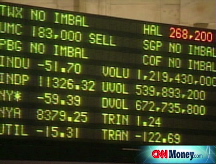The new math of lending
With banks tightening their credit standards, many have to walk a fine line when it comes to lending to consumers.
 |
| Loans are certainly harder to get and a lot more expensive nowadays for consumers. But banks can get burned if they push too hard on credit. |
NEW YORK (CNNMoney.com) -- Forget oil and gold. Credit might be the commodity that's in the scarcest supply these days.
Saddled by soaring loan losses, banks have been drastically tightening their lending standards, effectively putting credit out of reach for many consumers in search of mortgages, credit cards or car loans.
"Like the tide, credit goes in and out," said Jeff Davis, a bank analyst and managing director at FTN Midwest. "And right now it's headed out."
According to the Federal Reserve's first-quarter survey of senior loan officers at some of the nation's largest financial institutions, banks were turning away an increasing number of consumers because of credit fears.
The Fed is likely to report that this trend continued in the second quarter when it releases its latest senior loan officer survey later this month.
Banks endured rising loan losses in the quarter as the housing market deteriorated further and the economy sputtered.
Hoping to preserve capital and rid themselves of these troubled loans, financial companies have, as a result, held borrowers to a much higher standard.
Auto loan providers, for example, have increasingly favored borrowers with higher income levels and have pushed for shorter lending terms.
Hoping to clear out all the toxic mortgages from their books, banks and other lenders are also raising the bar for potential homebuyers, demanding bigger down payments and additional up-front fees, effectively pricing some shoppers out of the market.
And unlike in years past, fewer consumers are finding they can tap their home for cash via a home equity loan, notes Davis - unless you happen to be a prime borrower with a property where there is no pre-existing lien.
But by raising the bar, some would-be borrowers have fallen by the wayside.
"Once you start raising the standards, there will be that group of people that were on the borderline as far as underwriting criteria that may fall out," said Hugh Queener, chief administrative officer of Pinnacle Financial Partners (PNFP), a Nashville, Tenn.-based bank.
In addition to being tougher to get, credit is also a lot more expensive these days.
While the rates on various loans hinge on a variety of factors, such as the 10-year Treasury note and the prime rate, banks tend to have some leeway when it comes to setting lending rates. And some institutions are certainly taking advantage of this fact.
Some banks, for example, are boosting rates sharply on risky loans in order to avoid attracting any new business.
"They just don't want them," said Adam Schneider, a principal at Deloitte Consulting who deals with clients in the financial services industry. "They are pricing their way out of the problem."
Others are upping rates simply to make a few extra bucks.
"They are finding they are still able to grow their balance sheet and gain market share even with higher pricing," said Jefferson Harralson, an analyst with Keefe Bruyette & Woods.
"But my sense is that they are tiptoeing into it since they so unfamiliar with the lack of price competition," Harralson added.
But banks must also walk a fine line when it comes to credit.
Some beleaguered lenders, for example, may see the value in turning away new loans in order to preserve capital and to live on for another day.
While banks and investors are justifiably concerned about lending, it is also possible that by making credit standards too difficult, institutions are effectively turning away business and ultimately sacrificing earnings growth.
At the same, they run the risk of driving both existing and potential customers into the arms of their competitors - a risky proposition as borrowers can often be a repeat source of business.
Loan pricing can also be tricky.
Sky-high rates can ultimately scare away would-be borrowers to competitors. But even when a bank is able to get a borrower to take a high-interest loan, it has to be careful not to put themselves at risk.
If a banks sets rates too high and a borrower is unable to keep up with payments, the bank only has itself to blame when defaults happen.
"There is no amount of interest you can charge on a bad loan that will make up for it," said Queener. ![]()



